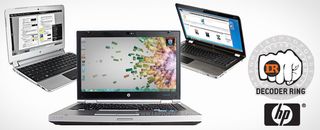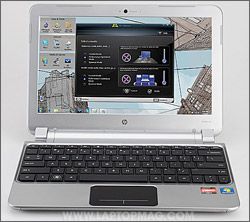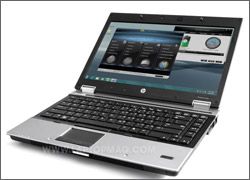HP Laptop Decoder Ring: Notebook Naming Demystified

With few exceptions, the way that notebook companies name their products can be highly confusing. What do all those letters and numbers mean? Look no further. We put together a cheat sheet to help you decipher the nomenclature vendors use so you’ll be able to know at a glance who it’s for, the size, and other features of any given system. You may even give the blue shirts a run for their money!
HP, in particular, has a huge variety of notebooks. On one end is a cadre of affordable Pavilion machines and at the other are high-end multimedia laptops that rival Apple's sleekest systems. Then you have a whole separate line of laptops for business users. To guide you through HP's catalog, here's a summary of each lineup.

HP Mini (Netbooks)
HP's line of 10.1-inch netbooks includes two models: the Mini 110 and the Mini 210 (pictured). The first number in the naming convention refers to the generation of the line, and the last two numbers reference the netbooks' size. Both machines offer an Intel Atom N455 processor and Intel GMA 3150 graphics, but the Mini includes a three-cell battery. The newer 210 packs a six-cell option.
HP G Series (Consumer Value)
Don't expect many models here. The all-over jet black HP G series features two laptops built for everyday computing tasks such as surfing the web, social networking, and watching online video. The G62m houses Intel Celeron processors, but the G62x gets into gear with a modern Core i3 370M CPU.

HP Pavilion (Consumer Mainstream)
Stay in the know with Laptop Mag
Get our in-depth reviews, helpful tips, great deals, and the biggest news stories delivered to your inbox.
The HP Pavilion line is easily the manufacturer's largest notebook family. It starts at the ultraportable 11-inch Pavilion dm1z (pictured) and climbs all the way to 17-inch quad-core rigs. In between, about a dozen sharp-looking machines are divided into the DM, G, and DV series, and come in a wide variety of chassis designs. The DM series includes HP's ultraportables; the G series includes value-priced 14-, 15-, and 17-inch notebooks; and the DV series (15- and 17-inch) is all about multimedia and entertainment, with features including premium sound and discrete graphics.
HP Envy (Consumer Luxury)
These four notebooks are HP's multimedia powerhouses. Available in 14- and 17.3-inch configurations, HP Envy laptops provide a strong mix of style and entertainment. For example, each notebook is designed with a minimalist flare and includes Beats audio sound. Depending on the system, an Envy can pack heavy-hitting A/V perks. The list includes ATI discrete graphics for video, a set of Beats headphones, and a 3D display (HP Envy 17 only).
HP Essentials (Small Business)
The HP Essential family is marketed toward small and medium-sized businesses who don't need a lot of computing power. Many of the notebooks contain bargain-priced CPUs such as the Intel Pentium T4500 or the AMD PhenomII.
The Essential is comprised of two notebooks: the 3105m is 11.6 inches and includes a modern AMD E-350 processor, and the 600 series offers several 15.6-inch machines that can house Intel Celeron, Core 2 Duo, or Pentium processors or equally low-end AMD chip selections as well.
HP TouchSmart (Consumer)
There's just one machine in this family: the TouchSmart tm2t, a 12.1-inch tablet with a convertible display and an emphasis on entertainment with HDMI, Dolby digital sound, and Altec Lansing speakers.
HP ProBook (Small to Medium Business)
The HP ProBook lineup offers something for every mobile professional—from roaming salespeople and real estate agents who need the lightweight mobility of the 5-pound 4420s and 4520s to engineers and designers who require big displays and bigger performance, as found in the 17-inch 4720s, which uses an ATI Radeon HD graphics card. There's even TPM software for encrypting important files and fingerprint readers to lock down notebooks in case the device lands in the wrong hands.

HP Elitebook (Corporate Business)
Mixing power and productivity with business features, the Elitebook lineup includes 12.1-, 14- , and 15.6-inch systems. These systems are also highly durable, designed to meet military specifications for ruggedness. It's also worth mentioning that nearly every Elitebook includes touchpad and point stick navigation in addition to first- or second-generation Intel Core processors.
The Elitebook line includes a subset of mobile workstations that offer top-of-the-line specs for creative professionals who need rugged and well-equipped notebooks. Available in 14-, 15.6-, and 17-inch sizes, the workstation machines can include a tougher chassis, Nvidia graphics, and spill-resistant keyboards. All include three-year warranties.
HP Model Number Tips
Screen Size: In the Pavilion line, the single number corresponds to the second digit of the screen size. The dm1z, for instance, is 11.1 inches. In some instance, the number represents the display's estimated size. The dv5t has a 14.5-inch display, so the 5 represents 15 inches, instead.
Elitebooks and ProBooks have more numbers in the product name, so it is the second number that refers to the screen size. For instance, the Elitebook 8440w and the 8460p both contain 14-inch displays. Exceptions to the rule are the Elitebook 2540p and 2740p, both 12.1 inches. For those systems, it is the first digit that corresponds to the second digit of the display size.
Processor: In the Pavilion line, the last letter refers to an Intel processor (t) or an AMD processor (z).
Subcategory: A "w" at the end of an Elitebook's title denotes "mobile workstation". A "p" means it is not a workstation.
